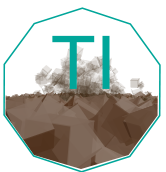Thallium

Thallium (Tl)
General Information
- Symbol: Tl
- Atomic Number: 81
- Atomic Weight: 204.38 u
- Element Category: Post-transition metal
- Group: 13
- Period: 6
- Block: p-block
Physical Properties
- Appearance: Silvery-white metallic, tarnishes to bluish-gray in air
- Density: 11.85 g/cm³
- Melting Point: 304 °C (579 °F)
- Boiling Point: 1473 °C (2683 °F)
- Phase at STP: Solid
- Electron Configuration: [Xe] 4f¹⁴ 5d¹⁰ 6s² 6p¹
- Oxidation States: +3 (common), +1
Chemical Properties
- Reactivity: Thallium is highly reactive, particularly with acids and oxygen. It rapidly forms a oxide layer when exposed to air.
- Compounds: Forms compounds such as thallium(I) chloride (TlCl), thallium(III) oxide (Tl₂O₃), and thallium sulfate (Tl₂SO₄).
Uses and Applications
- Electronics: Used in semiconductor materials for its electrical properties.
- Optics: Employed in infrared optical materials, including special glasses and lenses.
- Medical Imaging: Thallium-201 is used in nuclear medicine for stress tests to assess coronary artery disease.
- Pesticides and Rodenticides: Historically used in pesticides and rodenticides, although its use is now restricted due to toxicity.
- Superconductors: Used in high-temperature superconductors.
Occurrence and Extraction
- Natural Occurrence: Found in minerals such as crookesite, lorandite, and hutchinsonite. Often extracted as a byproduct of refining lead, zinc, and copper ores.
- Extraction: Extracted from flue dust or residues obtained during the smelting of these ores. The extraction process involves leaching with acids and then precipitation.
Isotopes
- Stable Isotopes: Thallium-203 and Thallium-205
- Radioactive Isotopes: Thallium-201, used in medical imaging, and several others used in scientific research.
Safety and Handling
- Hazards: Thallium and its compounds are highly toxic and can cause serious health issues, including neurological damage and organ failure. Symptoms of poisoning include hair loss, gastrointestinal distress, and nerve damage.
- Precautions: Handle with extreme care using appropriate protective equipment. Avoid inhalation, ingestion, and skin contact. Thallium should be stored in tightly sealed containers to prevent exposure to air.
History
- Discovery: Discovered by Sir William Crookes in 1861 through flame spectroscopy.
- Name Origin: Named after the Greek word “thallos,” meaning green shoot or twig, due to the bright green spectral emission lines.
Additional Facts
- Crystal Structure: Hexagonal close-packed (hcp)
- Magnetic Properties: Diamagnetic
- Thermal Conductivity: Low, about 46 W/m·K
- Electrical Resistivity: About 0.18 μΩ·m at room temperature
Summary
Thallium is a post-transition metal known for its high reactivity and toxicity. It has significant applications in electronics, optics, medical imaging, and superconductors. Found in various minerals and often extracted as a byproduct of refining other metals, thallium must be handled with extreme care due to its toxicity. Discovered by Sir William Crookes in 1861, thallium’s bright green spectral emission lines led to its naming.
40 Question and Answer Pairs About Thallium
What is the atomic number of Thallium?
- 81
What is the symbol for Thallium?
- Tl
What is the atomic weight of Thallium?
- 204.38 u
In which group of the periodic table is Thallium found?
- Group 13
What period is Thallium in?
- Period 6
What block does Thallium belong to?
- p-block
What is the melting point of Thallium?
- 304 °C (579 °F)
What is the boiling point of Thallium?
- 1473 °C (2683 °F)
What is the density of Thallium?
- 11.85 g/cm³
What is the electron configuration of Thallium?
- [Xe] 4f¹⁴ 5d¹⁰ 6s² 6p¹
What are the common oxidation states of Thallium?
- +3, +1
What is the appearance of Thallium?
- Silvery-white metallic, tarnishes to bluish-gray in air
Is Thallium reactive with air?
- Yes, it rapidly forms a oxide layer when exposed to air.
Name a compound of Thallium.
- Thallium(I) chloride (TlCl)
What is a common use of Thallium in electronics?
- Used in semiconductor materials.
How is Thallium used in optics?
- Employed in infrared optical materials, including special glasses and lenses.
What role does Thallium play in medical imaging?
- Thallium-201 is used in nuclear medicine for stress tests.
How was Thallium historically used in pesticides?
- Used in pesticides and rodenticides, though now restricted due to toxicity.
What application does Thallium have in superconductors?
- Used in high-temperature superconductors.
Name a mineral that contains Thallium.
- Crookesite
How is Thallium extracted from ores?
- Extracted from flue dust or residues obtained during the smelting of ores.
What is the most stable isotope of Thallium?
- Thallium-205
Name a radioactive isotope of Thallium used in medical imaging.
- Thallium-201
What safety hazard is associated with Thallium compounds?
- Highly toxic and can cause serious health issues.
Who discovered Thallium?
- Sir William Crookes
Where does the name Thallium come from?
- From the Greek word “thallos,” meaning green shoot.
What is the crystal structure of Thallium?
- Hexagonal close-packed (hcp)
Is Thallium paramagnetic or diamagnetic?
- Diamagnetic
What is the thermal conductivity of Thallium?
- About 46 W/m·K
What is the electrical resistivity of Thallium at room temperature?
- About 0.18 μΩ·m
What is the primary oxidation state of Thallium?
- +3
Is Thallium found as a free element in nature?
- No, it is found in minerals like crookesite.
What is the common name of thallium sulfate?
- Tl₂SO₄
What is a major application of thallium(I) chloride?
- Used in optical materials and infrared detectors.
How does Thallium benefit medical imaging?
- Thallium-201 is used for stress tests to assess coronary artery disease.
What is the boiling point of Thallium in Kelvin?
- 1746 K
What group does Thallium belong to in the periodic table?
- Post-transition metals
What is the natural abundance of Thallium-205?
- About 70.5%
Can Thallium be used in high-temperature applications?
- Yes, in certain specialized high-temperature superconductors.
What precaution should be taken when handling Thallium?
- Handle with extreme care using appropriate protective equipment to avoid exposure.






